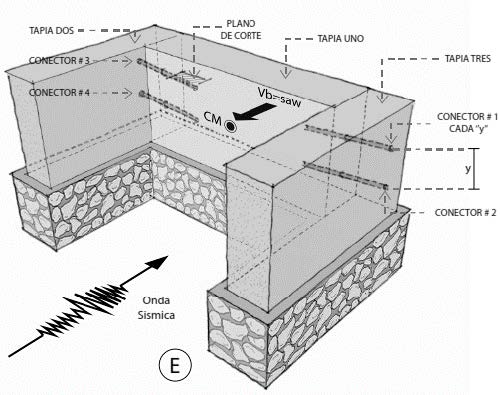Mechanical behavior of Tapia and Corner connections. Case Imperial Theater of Pasto
DOI:
https://doi.org/10.17981/ingecuc.14.2.2018.08Keywords:
Structural pathology, seismic threat, historical heritage, rehabilitation of buildings, physical-mechanical characterization of materialsAbstract
Introduction: The Tapia, is an ancestral wall material made by hand in packed earth, which heritage buildings were built within Pasto City, (area of high seismic threat) including the Imperial Theater (1922), known as the “Dean of the Southern Theaters” declared it as one of the real estate of cultural interest of the nation, protected by the Ministry of culture’s laws.
Methodology: The investigation is developed from pathological evaluation caused by seismic antecedents in the structural behavior by buckling and corner connection of buildings on land, for this the physical mechanical behavior of the wall is evaluated from conventional processes such as the breaking module , evaluation of admissible resistance to the compression of the wall, as a response to buckling and dynamic assessment to characterize the damping ratio and resonance frequency based on the evaluation of free vibrations. As a methodology, the research proposes a new test from a piece that allows establishing the efforts that are developed in the corner connection and the reinforcement that counteracts this vulnerability.
Results: The Tapia wall is characterized as a deformable solid highly fragile, subject to buckling and cracking which was assessed as a continuous medium based on the calculation of elasticity (72 Mpa), shear (28Mpa), ratio of vertical and horizontal deformation (0.33) and compressive strength (0.59 Mpa) characterized as a consolidated soil of medium hard consistency, with a modulus of rupture (0.14Mpa).
Conclusions: It is possible to improve the behavior of buildings on land subjected to bending stress, applying a reinforced cloth with cement floor and reinforcing mesh. The detachment of the corners of the walls is presented by the high concentration of efforts, which are resolved by the installation of connectors or nails. The free vibration test allows to obtain the longitudinal, transversal and torsional vibration modes to determine the damping capacity of the dynamic action caused by an earthquake. The breaking module allows to interpret the capacity of response in front of the bending and buckling that is caused in a wall in the wall.
Downloads
References
H. Bolaños, Los nombres sin olvido, San Juan de Pasto, 1979, p. 20.
M. Enríquez Guerrero, O. Mesías Rosas and R. Ortega Enríquez, Estudio histórico y gráfico de la Arquitectura Republicana en San Juan de Pasto, San Juan de Pasto, Colombia: Imprelibros, 2005.
R . Valladares, Diálogos entre ciudad, medio ambiente y patrimonio, México DF, México: Universidad de Colima, 2014.
C. D. Tecnológico, “Manual del Terreno - Evaluación de daños y soluciones para construcción en Tierra Cruda”., R.F. Ltda, Ed., Santiago de Chile, 2012, p. 15.
W. Pasuy, “Teatro Imperial de Pasto un Patrimonio Vivo,” en Experiencias y Métodos de Restauración en Colombia, Vol. I, Roma, Aracne editrice Roma, 2011.
H. Coral Moncayo, Reseña Histórica de los Terremotos en Nariño, San Juan de Pasto, Colombia: Universidad de Nariño, 2004.
Ministerio de Cultura, Ley 1188 de 2008, “Legislación y normas generales para la gestión, protección y salvaguardia del patrimonio cultural en Colombia”, Bogotá D.C, Colombia.
P. Ángulo, G. Balza, L. Gonzáles, M. Labrador, C. Quintero, “Bloque de adobe como sistema de cerramiento vertical de viviendas en el páramo Venezolano”, I.U.P. Santiago Mariño. Ing. Civil, Mérida, Venezuela 2016, p. 18.
Congreso de Colombia, Ley 400 de 1997, “Normas colombianas de diseño y construcción sismo resistente”. NSR -98. Asociación Colombiana de Ingeniería Sísmica, Bogotá DC, Colombia, 1997
Ministerio de Ambiente, Vivienda y Desarrollo Territorial, Reglamento colombiano de construcción sismo resistente. NSR - 10, Bogotá DC, Colombia, 2012.
W. Castillo Valencia and G. Sánchez, “Informe final de análisis de vulnerabilidad sísmica mediante recolección visual de datos estadísticos de los predios comprendidos entre las calles 16 a 21 y las carreras 22 a 27, implementado en planos de mapas y riesgo,” San Juan de Pasto, Colombia, 2013.
G. M. Viñuelas, Restauración de Arquitectura de Tierras, Buenos Aires, Argentina, 2009, p. 48.
Iscarsah, Recomendaciones para el análisis, conservación y restauración estructural del patrimonio arquitectónico, Barcelona, España, 2004.
E . Carnevale , B. Rakotomamonjy , E. Sevillano and M. Abad, “Orientaciones Para la Conservación de Inmuebles Patrimoniales de Tierra en Cuenca”, I. N. d. P. Cultural, Ed., Cuenca, Ecuador, 2015, p. 61.
A. G. Lozano Martinez, Fichas técnicas de soluciones constructivas para la rehabilitación del patrimonio arquitectónico rural, Escuela Técnica Superior de Ingeniería, Universidad de Oviedo, Barcelona, España: Universidad de Oviedo, 2011.
Gobierno del Estado de Puebla. Consejo Estatal para la Cultura y las Artes de Puebla, UNAM, Guía para Proyectos de Restauración, Puebla, México: Secretaría de Cultura de Puebla, 2015.
A. L. Muller, Ed.”El Teatro Imperial,” Ilustración Nariñense, no. 57, 13 - 14 Junio 1935.
D. Tovar, J. Vergara, “Determinación de los módulos dinámicos para un suelo lacustre de Bogotá mediante ensayo
triaxial cíclico”, Universidad de La Salle, Bogotá D.C., Colombia, 2016.
P. Reyes and J. Rosales, “Ensayos Para La Obtención De Propiedades Dinámicas De Un Suelo mh Estabilizado Con Caucho Triturado,” Cali, Colombia, 2017.
J. Brazan Sanchez, R. Gonzales Cruz and H. Ortiz Landaverde, “Métodos de ensayos para la determinación de las principales propiedades dinámicas de los suelos de el Salvador,” Tesis de Grado, Escuela de Ingeniería Civil, Universidad de El Salvador, San Salvador, El Salvador, 2009.
L. F. Velasco, “Apuntes de intervención en edificaciones en tierra. Apuntes y notas de intervención de patrimonio,” Popayán, 1999

Downloads
Published
How to Cite
Issue
Section
License
Published papers are the exclusive responsibility of their authors and do not necessary reflect the opinions of the editorial committee.
INGE CUC Journal respects the moral rights of its authors, whom must cede the editorial committee the patrimonial rights of the published material. In turn, the authors inform that the current work is unpublished and has not been previously published.
All articles are licensed under a Creative Commons Attribution-NonCommercial-NoDerivatives 4.0 International License.


 English
English
 Español (España)
Español (España)






















